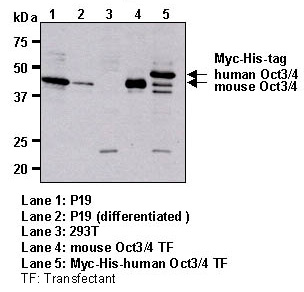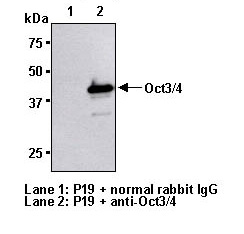Antibody detailed product information
| Code No. | PM048 | |
| Anti-Oct3/4 pAb | ||
| Size | 100 µL | |
| Availability (in Japan) | 1-9
(In Japan at 00:05, Apr 24, 2024 in JST) |
|
| Clonality | Polyclonal | |
| Clone | polyclonal | |
| Isotype (Immunized Animal) |
Rabbit Ig (aff.) | |
| Applications | WB 1:1,000 IP 2 µL/300 µL of cell extract from 3 x 106 cells IC IH 1:500 |
|
| Immunogen (Antigen) |
Recombinant Mouse Oct3/4 N-terminal (1-134 aa) | |
| Reactivity [Gene ID] | ||
| Storage buffer | PBS/50% glycerol, pH 7.2 | |
| Storage temp. | -20°C | |
| Conjugate | Unlabeled | |
| Manufacturer | MBL | |
| Alternative names | POU5F1, OCT3, OCT4, OTF3, OTF4, OTF-3 | |
| Background | The POU family transcription factor Oct-3/4, termed as Oct-3 or Oct-4, encoded by Pou5f1, is expressed in totipotent/pluripotent early embryonic cells. It is also expressed in embryonic stem (ES) cells and embryonal carcinoma (EC) cells, but its expression diminishes when these cells differentiate and lose pluripotency. Oct3/4 contains three functionally characterized domains, the transcriptional activation domain of N- and C-terminal region and the POU DNA-binding domain. The POU domain binds to an octamer sequence, ATTTGCAT. Several target genes of Oct3/4, such as Sox2, contains an octamer element capable of binding Oct3/4. These sites are important for transcriptional activity. Induced pluripotent stem (iPS) cells can be generated from mouse embryonic or adult fibroblasts by induction of four factors, Oct3/4, Sox2, c-Myc, and Klf4. Oct3/4 regulates a expression of Tcl1 (T cell lymphoma break point) and Nanog and contributes to cell proliferation and stabilization of cell pluripotency. Two transcription factors Oct3/4 and Sox2 works together to control a transcriptional regulatory network that regulates the expression of other essential genes. | |
| Related products | D356-3 Anti-Jmjd1c (Mouse) mAb PM056 Anti-Sox2 pAb PM057 Anti-KLF4 pAb PM058 Anti-Nanog (Mouse) pAb |
|
| Product category | Research area:Stem cell research | |
| Data |     |
|
| Citations | Immunocytochemistry
Immunohistochemistry
|
|
- The availability is based on the information in Japan at 00:05, Apr 24, 2024 in JST.
- The special price is shown in red color.
- Please note that products cannot be ordered from this website. To purchase the items listed in this website, please contact us or local distributers.
- Abbreviations for applications:
WB: Western Blotting, IH: Immunohistochemistry, IC: Immunocytochemistry, IP: Immunoprecipitation
FCM: Flow Cytometry, NT: Neutralization, IF: Immunofluorescence, RIP: RNP Immunoprecipitation
ChIP: Chromatin Immunoprecipitation, CoIP: Co-Immunoprecipitation
DB: Dot Blotting, NB: Northern Blotting, RNA FISH: RNA Fluorescence in situ hybridization - For applications and reactivity:
*: The use is reported in a research article (Not tested by MBL). Please check the data sheet for detailed information.
**: The use is reported from the licenser (Under evaluation or not tested by MBL).
- For storage temparature: RT: room temparature
- Please note that products in this website might be changed or discontinued without notification in advance for quality improvement.
 Copyright (C)2015 Medical & Biological Laboratories Co., Ltd. All Rights Reserve
Copyright (C)2015 Medical & Biological Laboratories Co., Ltd. All Rights Reserve